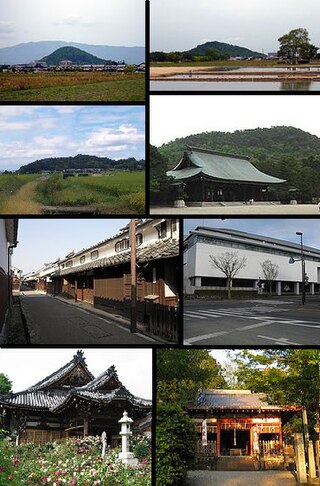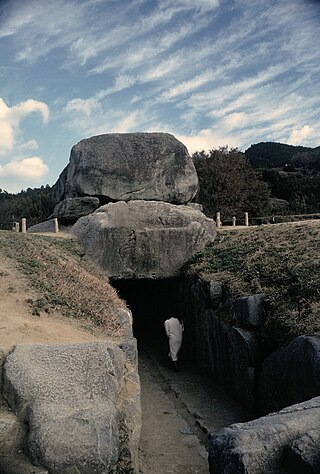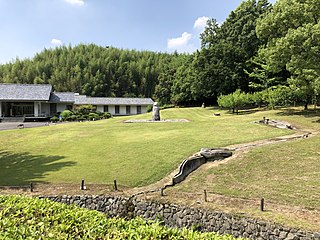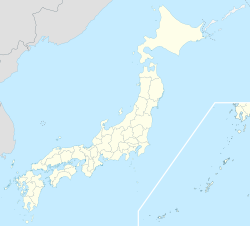
Habikino is a city located in Osaka Prefecture, Japan. As of 31 January 2022, the city had an estimated population of 109,479 in 50918 households and a population density of 4100 persons per km2. The total area of the city is 26.45 square kilometres (10.21 sq mi). The city is known for its grapes, and also for its large number of ancient kofun burial mounds. The city is also sometimes referred to by its former name Minami-Osaka (南大阪).

Kashihara is a city located in Nara Prefecture, Japan. As of April 1, 2015, the city has an estimated population of 124,829, with 52,034 households.

Sakurai is a city located in Nara Prefecture, Japan. As of 31 August 2024, the city had an estimated population of 54,384 in 25678 households, and a population density of 550 persons per km2. The total area of the city is 98.91 km2 (38.19 sq mi).

Takatori is a town located in Takaichi District, Nara Prefecture, Japan. As of 30 September 2024, the town had an estimated population of 6,081 in 2820 households, and a population density of 240 persons per km2. The total area of the city is 25.79 km2 (9.96 sq mi).

Kofun are megalithic tombs or tumuli in Northeast Asia. Kofun were mainly constructed in the Japanese archipelago between the middle of the 3rd century to the early 7th century AD.

The Takamatsuzuka Tomb is an ancient circular tomb in Asuka village, Nara Prefecture, Japan.

The Kitora Tomb is an ancient tumulus located in the village of Asuka, Nara Prefecture, Japan. The tomb is believed to have been constructed some time between the 7th and early 8th centuries, but was only discovered in 1983.

Fujiwara-kyō (藤原京) was the Imperial capital of Japan for sixteen years, between 694 and 710. It was located in Yamato Province, having been moved from nearby Asuka. However, the name itself was never used in the Nihon Shoki; during those times it was recorded as Aramashi-kyō (新益京).

Nara is the capital city of Nara Prefecture, Japan. As of 2022, Nara has an estimated population of 367,353 according to World Population Review, making it the largest city in Nara Prefecture and sixth-largest in the Kansai region of Honshu. Nara is a core city located in the northern part of Nara Prefecture bordering the Kyoto Prefecture.

Kashiharajingū-mae Station is a train station located in Kashihara, Nara Prefecture, Japan. It is on Kintetsu Kashihara Line, Minami Osaka Line and Yoshino Lines. It is one of the major stations on the Kintetsu lines and all trains in service stop at this station.

Ishibutai kofun (石舞台古墳) is a stone kofun or tumulus of the Asuka period in the east of Shimanoshō, Asuka, Nara Prefecture, Japan. The kofun is believed to be the tomb of Soga no Umako. It occupies an area of 27 m2 (291 sq ft), and is the largest known megalithic structure in Japan. The kofun is also known as the Ishibutoya (石太屋) Kofun. It is located 5 km from Tanzan Shrine.

Asuka (飛鳥) was the Imperial capital of Japan during the Asuka period, which takes its name from this place. It is located in the present-day village of Asuka, Nara Prefecture.

Okadera Station is a railway station located in Kashihara, Nara, Japan.

Asuka Station is a railway station located in Asuka, Takaichi, Nara, Japan, on the Kintetsu Railway Yoshino Line.
Asuka-Fujiwara: Archaeological sites of Japan’s Ancient Capitals and Related Properties is a cluster of archaeological sites from in and around the late sixth- to early eighth-century capitals of Asuka and Fujiwara-kyō, Nara Prefecture, Japan. In 2007, twenty eight sites were submitted jointly for future inscription on the UNESCO World Heritage List under the ii, iii, iv, v, and vi criteria. Currently, the submission is listed on the Tentative List.

The Asuka Historical Museum is a historical museum in Okuyama, Asuka, Nara Prefecture, Japan. The museum was founded in 1975 and is a unit of the Nara National Research Institute for Cultural Properties.

The Tosaka-dera was an Asuka period Buddhist temple located in the Takaida neighborhood of the city of Kashiwara, Osaka, Japan. The temple no longer exists, but the temple grounds were designated as a National Historic Site in 2012. The site was formerly referred to as the Takaida temple ruins until positively identified in 1983.

Miyakozuka Kofun (都塚古墳) is a Kofun period burial mound, located in the Sakata neighborhood of the village of Asuka, Nara in the Kansai region of Japan. The tumulus was designated a National Historic Site of Japan in 2017. It is also known as the Kinchozuka Kofun (金鳥塚) and is believed to be the tomb of Soga no Iname (d.570).

Ishinokarato Kofun (石のカラト古墳) is a burial mound, located on the border of the Kabutodai neighborhood of the city of Kizugawa, Kyoto and the Jingū neighborhood of the city of Nara in the Kansai region of Japan. The tumulus was designated a National Historic Site of Japan in 1996. On the Kyoto Prefecture side, it is referred to as the Kazahahi Kofun (カザハヒ古墳).

























